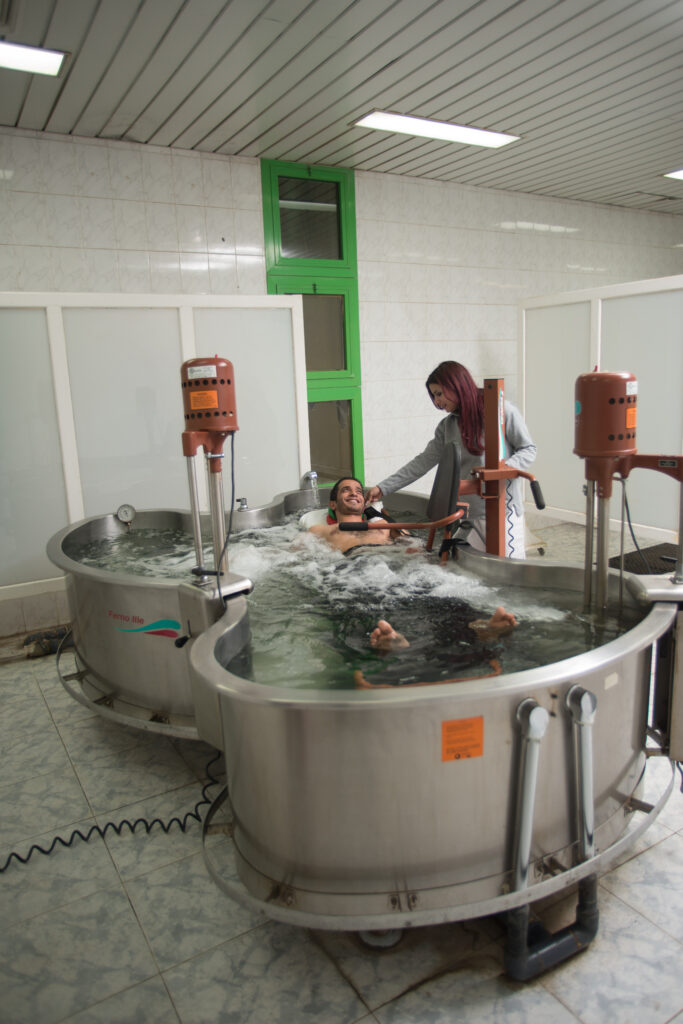Hydrotherapy

Hydrotherapy, also known as water therapy or aquatic therapy, involves the use of water for pain relief and treatment. It encompasses a variety of techniques and treatments that take advantage of the physical properties of water, such as temperature, buoyancy, and pressure, to promote healing and improve physical function. Here’s an in-depth look at hydrotherapy:
Key Concepts of Hydrotherapy
1. Buoyancy:
- Purpose: To reduce the effects of gravity and support the body, making movement easier and reducing joint stress.
- Benefits: Allows for greater range of motion and decreases pain during exercises.
2. Temperature:
- Purpose: To use warm or cold water to stimulate blood flow, relax muscles, and reduce pain and inflammation.
- Benefits: Warm water can relax muscles and increase circulation, while cold water can reduce inflammation and numb pain.
3. Hydrostatic Pressure:
- Purpose: To apply uniform pressure on the body, which can improve circulation and decrease swelling.
- Benefits: Helps in reducing edema and improving joint and soft tissue support.
Types of Hydrotherapy
1. Aquatic Exercise and Rehabilitation:
- Purpose: To perform exercises in water to improve strength, flexibility, and cardiovascular fitness.
- Methods: Includes swimming, water aerobics, and specific therapeutic exercises guided by a therapist.
2. Contrast Bath Therapy:
- Purpose: To alternate between hot and cold water to stimulate blood flow and reduce inflammation.
- Methods: Immersing the body or a body part alternately in hot and cold water.
3. Warm Water Therapy:
- Purpose: To relax muscles, relieve pain, and improve circulation.
- Methods: Using warm baths, hot tubs, or hydrotherapy pools.
4. Cold Water Therapy:
- Purpose: To reduce inflammation and numb pain.
- Methods: Cold baths, ice packs, or cold compresses.
5. Whirlpool Therapy:
- Purpose: To use water jets to massage and relax muscles.
- Methods: Immersing in a whirlpool bath with jets providing targeted massage.
6. Watsu (Water Shiatsu):
- Purpose: To combine water therapy with Shiatsu massage techniques.
- Methods: A therapist supports and gently moves the patient through warm water, applying stretches and massage.
Benefits of Hydrotherapy
- Pain Relief: Warm water can soothe aches and pains, making it easier to perform exercises and activities.
- Increased Range of Motion: The buoyancy of water reduces stress on joints, allowing for easier movement.
- Enhanced Circulation: Warm water can improve blood flow, aiding in the healing process.
- Reduced Swelling and Inflammation: Hydrostatic pressure helps decrease edema and supports injured tissues.
- Relaxation and Stress Reduction: The soothing properties of water can promote relaxation and reduce stress and anxiety.
- Improved Strength and Endurance: Water resistance can help build muscle strength and improve cardiovascular fitness.
Conditions Treated with Hydrotherapy
- Arthritis: Reduces joint pain and stiffness, increases range of motion.
- Musculoskeletal Injuries: Aids in the recovery of fractures, sprains, and strains.
- Neurological Conditions: Benefits patients with multiple sclerosis, Parkinson’s disease, or stroke by improving mobility and reducing spasticity.
- Chronic Pain: Helps manage conditions like fibromyalgia and chronic back pain.
- Rehabilitation Post-Surgery: Assists in the recovery process after orthopedic surgeries.
Techniques and Practices in Hydrotherapy
1. Hydrotherapy Pools:
- Purpose: To provide a controlled environment for water therapy.
- Features: Typically heated pools with features like water jets, adjustable depth, and equipment for support.
2. Underwater Treadmills:
- Purpose: To combine the benefits of water buoyancy with the exercise of walking or running.
- Features: Treadmills submerged in water, often used for rehabilitation and fitness training.
3. Water Aerobics:
- Purpose: To perform aerobic exercises in water for cardiovascular and strength benefits.
- Features: Classes or individual routines that include a variety of movements to engage different muscle groups.
4. Jacuzzis and Hot Tubs:
- Purpose: To use warm water and jets for relaxation and muscle pain relief.
- Features: Heated tubs with massaging jets that provide a therapeutic massage.
